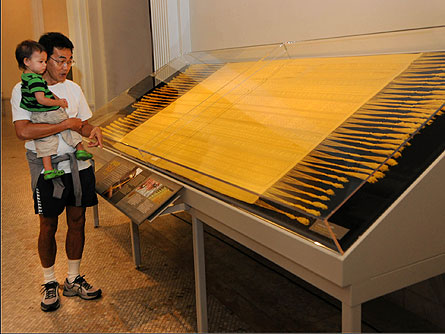Spider men weave silken tapestry
Here’s a hobby for weavers who adore eight-legged spinners and have too much time on their hands. Way too much time.



Indeed, Simon Peers and Nicholas Godley can tell you why it may require a village — and four years or more — to create a single major textile from spider silk. But their team’s effort is so magnificent that starting today the American Museum of Natural History, in New York, has it on display. You’ve got six months to see it there, after which you’ll have to go museum hopping in London to catch up with it.
A Brit, Peers immigrated to Madagascar a couple decades ago and set up a business to rediscover and promote that island nation’s woven artistic heritage. At some point, maybe 18 years ago or so, he learned of what at first sounded like an apocryphal tale. It described a piece of fabric that had been woven from threads of spider silk.
Intrigued, he chased down the story. Eventually he confirmed that someone had produced enough silk to weave a textile, which was exhibited at the World’s Fair in 1900 — the Paris Exposition Universelle. “It was a sort of sheer, very plain silk weave,” Peers notes. And although it was apparently big, “all of the sources that refer to it conflict in terms of its size.” Try as he might to hunt it down, he says it’s vanished.
Over the past three centuries, beginning in 1709, a guy here or there has produced a pair of spider-silk gloves or stockings and presented them to royalty, Peers learned. But despite years of looking, the only extant pieces appear to be two small remnants of plain-weave fabric in Lyon, France.
At some point, Peers shared what he had learned with a friend who was doing academic research on Madagascar’s textiles. “And she enthused about this whole idea of spider silk,” Peers recalls. “In fact, she pursued it a little further than I did,” turning up details of the original machine that was used to “silk” spiders for that World’s Fair fabric. While in France, she had one small element of the silker reproduced and made Peers a present of the mechanical piece.
It then sat on a shelf in his office for years. Many, many years.
Eventually, Godley, another manufacturer of Madagascan textiles, noticed it while visiting Peers. When he heard what it was, he couldn’t forget it. After a few years Godley moved his company to the capital city, Antananarivo, where he could join forces with Peers to begin working with spider silk.
After tracking down archival information on the history of this material and the machine that could extract the strong fibers from these tiny animals, the two textile experts applied some modernizations. Then they had their 21st century silker manufactured. It can pull silk from 24 spiders at a time.
For their massive project, Peers and Godley used a local species, the golden orb spider (Nephila madagascariensis). They temporarily harnessed each live spinner while some 80 feet of saffron-hued silk was extracted from a spinneret at the end of her abdomen. Yes, her abdomen, since only females build webs.
Every spider was gently restrained in the silker for the five to 10 minute procedure, then returned to her box. The two-dozen strands that were pulled from each team of silked spiders were immediately twisted together and wound onto a bobbin. Eventually, four of these multi-stranded lines were twisted together to create the ultimate textile thread.
It took a lot of spiders to make the 11-by-4-foot fringed tapestry that went on display today. Some 1,063,000 individuals, give or take (although it’s certainly possible some were silked more than once). Teams of up to 80 people went out every day carefully collecting spiders from webs in town and the countryside. Spider wranglers would rebox each silked animal for release back into the wild a few hours later. In theory, no spider gave her life for the production of Peers’ and Godley’s arachno-craft.
Of course, it would have been easier if the weavers could just have farmed their spiders, silking them at regular intervals. Alas, Peers notes, the females are cannibalistic “so we’d have had this endlessly diminishing stock.”
It took the better part of three years to get enough silk for the team to begin weaving in earnest. The thread’s elasticity — it can stretch up to 40 percent of its resting length — made the silk difficult to work with. But it proved very strong, Peers says, “and never broke, which was wonderful because ordinary silk does break.”
Weavers created the golden fabric in panels and then assembled them together into the final tapestry. Woven into that fabric was a floral pattern that includes birds.
“It really is mind-boggling the amount of time that’s been invested in this [piece],” Peers says. How much time? “Hundreds of thousands of hours,” he estimates, if you count the spider collecting, silking and weaving. But Peers and Godley set out to create a work of art that was “truly unique and extraordinary.”
And they succeeded.






